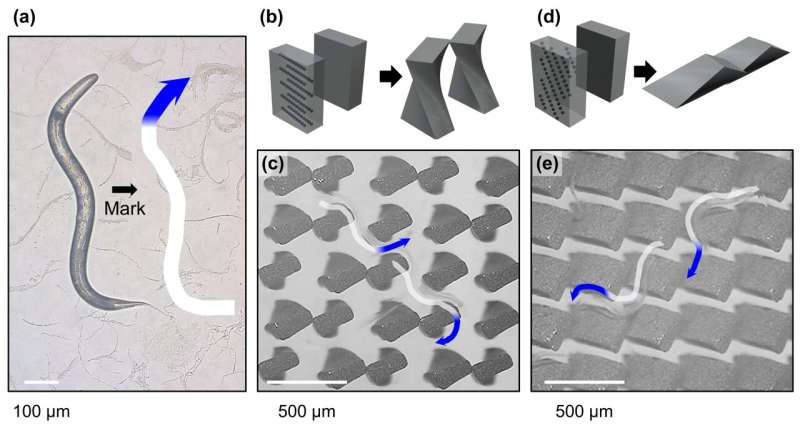Guiding worm locomotion with magnetically reconfigurable microtopographies

The living worm Caenorhabditis elegans (C. elegans) has ~60% gene similarity to humans. This similarity has been studied to develop therapies for age-induced diseases, such as Alzheimer's disease and amyotrophic lateral sclerosis. However, the research investigating these worms needs advancement to reveal relationships between locomotion abilities and sensory neurons.
Researchers from Hanyang University have demonstrated physically guided multi-modal locomotion of the worms using magnetically shape-reconfigurable microtopographies. Their research was recently showcased on the front page of Advanced Science.
The study, published in Advanced Science, is the first to selectively manifest locomotion modes of C. elegans depending on changes in the microtopographical environments of the worm as well as the premier study suggesting the possibility of exploiting C. elegans as a sub-millimeter scale biobot. The biobot, a word combining bio and bot (robot), implies that the human can control the behaviors of the non-human living creature.
Conventional robots work by utilizing a battery and circuits intricately programmed through software. However, the living worm moves by perceiving surroundings. Using sensory neurons located in its head, body, and tail, the worm responds with complex curvilinear motility without the need to implant any additional devices.
For example, C. elegans performs sinusoidal swimming in barrier-free chambers. However, at topographies with rectangular microbarriers, the worm moves linearly by mechanosensing the barriers with its neurons. Along with this linear translation, C. elegans searches pathways favorable to its curvy body shaped like a snake. The researchers have named this a navigating movement, passing among rectangular microbarriers.
A unique point of this work is that the microbarriers, consisting of iron particles and elastomeric polymers, can change its morphology at increasing magnetic flux density. C. elegans perceives changes in interbarrier spacings and heights of microbarriers, and converts locomotion modes from the navigating movement to circumventing movement or climbing.
Notably, the researchers have demonstrated locomotion selectivity of C. elegans. The biobot shows circumventing movement at twisted and paired microbarriers, while climbing appears at twisted and bent microbarriers. These two types are considered maze-like and stair-like microtopography, respectively.
For maze-like topography, the twisted and paired microbarriers provide C. elegans with a narrowed gap between the barrier-bases. Since this gap is narrower than head lengths and body widths of C. elegans, the worm cannot pass through and circumvents pathways in this microtopography. In the case of the stair-like topography, the twisted and bent microbarriers act as microsteps for C. elegans to climb. Interesting to note, this climbing becomes faster as the height of microsteps becomes comparable to the head lengths of C. elegans. The velocities of climbing and circumventing movement are the fastest ~0.46 BL s−1 and slowest ~0.09 BL s−1, respectively, compared to other locomotion modes reported in this work.
Furthermore, the researchers demonstrate that these multi-modal locomotion modes clearly differ between the wild type and mutant strains that have gene disorders in the neurons of the head, body, and tail. Notably, trp-4(sy695) strain cannot circumvent microtopography due to mutation of head/tail neurons, while mec-4(e1339) strain cannot climb microtopography because of mutation of body neurons.
This research is the first report on locomotion modes of worms physically guided by magnetically reconfigurable microtopgraphies, not with electrical stimulation or chemical treatments. Future research will expand on current findings with the assistance of computational simulations that will help establish drug screening platforms for treating neurological diseases in humans. Efficacy of a drug in development may be confirmed by observing whether C. elegans of wild type and mutant strains perform locomotion modes with recovered mechanosensing ability following drug treatments.
More information: Jeong Eun Park et al, Multi‐Modal Locomotion of Caenorhabditis elegans by Magnetic Reconfiguration of 3D Microtopography, Advanced Science (2022). DOI: 10.1002/advs.202203396
Journal information: Advanced Science
Provided by Hanyang University



















